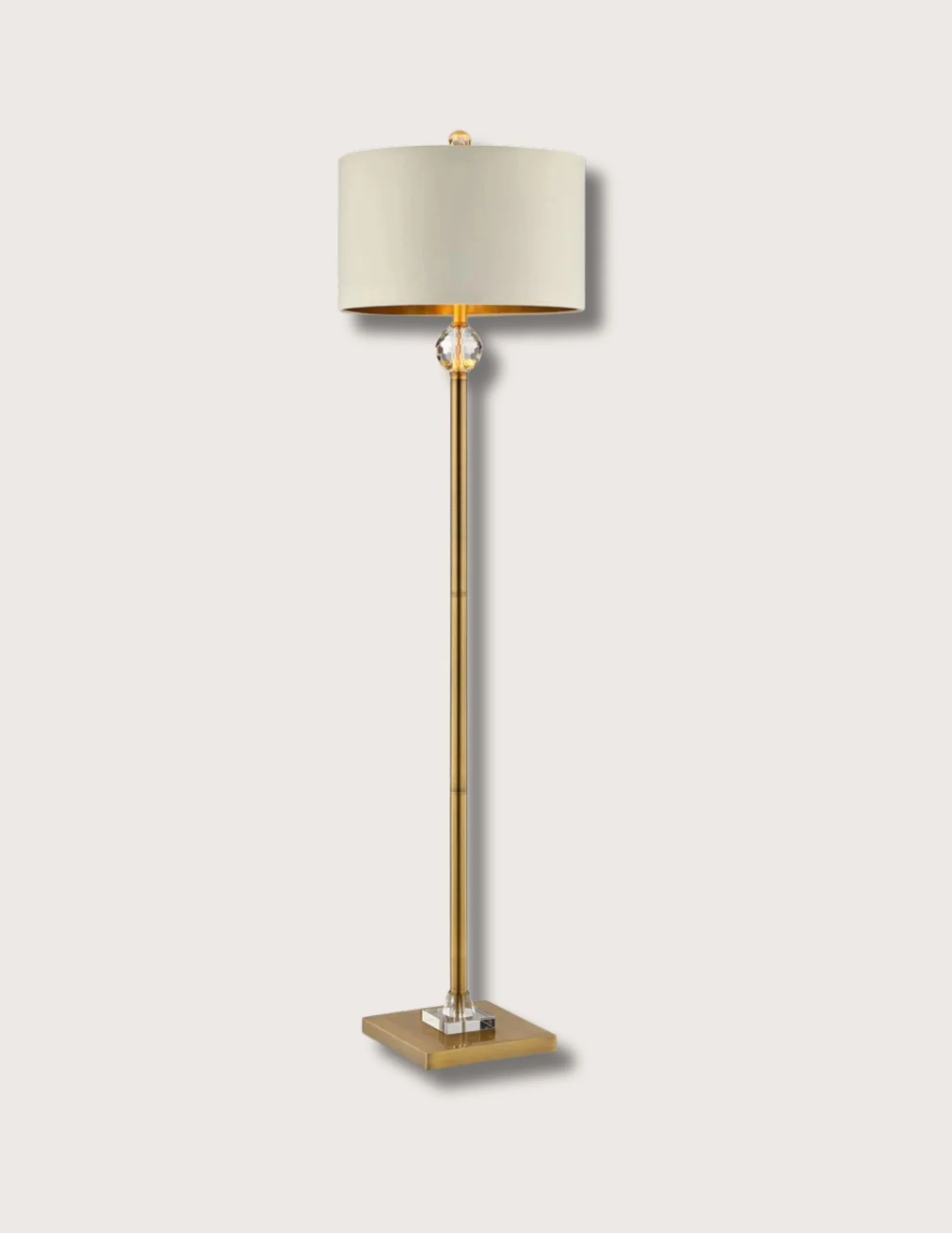 Image 1 of 4
Image 1 of 4

 Image 2 of 4
Image 2 of 4

 Image 3 of 4
Image 3 of 4

 Image 4 of 4
Image 4 of 4





Langston Table Lamp
Details
Light up your office, living room or bedroom with our Langston Table Lamp. This mid-century table lamp features a stylish, eye-catching triangular shape, and walnut wood grain finish. The warm wood finish meets a classic white shade and metallic gold accents for a sophisticated look. Featuring a striking architectural silhouette, the Langston Table Lamp will make the perfect accent piece or finishing touch for any room in your home.
Editors' Note
This piece is named for the seminal writer, poet and icon of the Harlem Renaissance — Langston Hughes. Born James Mercer Langston Hughes in Joplin Missouri in 1901 (1902 according to Hughes himself), the eventual author hailed from an accomplished African American family. Among his notable ancestors are his grandmother, Mary Sampson Patterson Leary Langston, an abolitionist who was one of the first Black women to graduate from Oberlin College. Mary operated a station in the Underground Railroad alongside her first husband, Lewis Sheridan Leary, until he was killed participating in John Brown's famous raid on Harper's Ferry. Other of Hughes' significant forbears include Mary's second husband — Langston's grandfather — Charles Henry Langston, an accomplished abolitionist appointed general superintendent of Refugees and Freedmen for the Freedmen's Bureau in Kansas following the Civil War. And Charles’s younger brother — attorney, congressman and U.S. diplomat, John Mercer Langston — who was the founding dean of Howard University Law School. Following the split of his mother, Caroline Langston Hughes (who went by several permutations of her name throughout her life), and father James Nathaniel Hughes, Hughes was raised primarily by his grandmother. His parents would be infrequent presences in his life, as his mother traveled extensively seeking work, and his father, dissatisfied with the conditions of Black life in America (and with Black people themselves, as Hughes would later remember him as hating himself and all "Negroes"), sought a new life in Mexico where he became a lawyer and landowner. Langston would live — intermittently and uncomfortably — with all three before briefly attending Columbia University to study engineering. Despite compromising with his father on his choice of major (Hughes wanted to study to become an author), Hughes left Columbia in 1922 after only a year, repulsed by the racism of his classmates and the institution, which denied him a dorm room. Living instead at a YMCA, and working by turns as a cook, busboy and launderer while attending school, Hughes encountered the vibrant cultural center that was Harlem. While at Columbia, Hughes worked at the university newspaper, publishing poems under the pen name, Lang-Hu. After leaving school, however, Hughes broadened his experience, serving for six months in 1923 on the S.S. Malone, a freighter traveling between New York and ports in Africa, the Canary Islands and Europe. Leaving the ship in Europe he resumed his role as a busboy, this time at Le Grand Duc, a nightclub in Montmartre, France. Returning to the U.S. in 1924, he worked for Carter G. Woodson at the bustling Washington D.C. headquarters of Woodson's publishing house and research library. A poet since his youngest days, Hughes left Woodson's employ in 1925 to work as a busboy at the Wardman Park Hotel, also in D.C., as it would allow him to devote more time to his craft. There he met celebrated American poet Vachel Lindsay who became an instant supporter, as had writer and Harlem Renaissance patron Carl Van Vechten, whom he had met a year earlier in 1924. Van Vechten aided Hughes in publishing his first book of poetry, The Weary Blues, in 1926. From there Hughes' career is the stuff of legend. An incredibly versatile literary talent — poet, author, playwright, columnist, and lecturer — Hughes stands comfortably alongside Zora Neale Hurston, Countee Cullen, Wallace Thurman and Claude McKay as among the strongest literary pillars of the Harlem Renaissance. Yet, Hughes was not always so well regarded. He was remembered by Lindsay Patterson, a novelist and former assistant as, "critically, the most abused poet in America." In addition to the scorn that racist, white reviewers had for most Black writers, Hughes was often lambasted by Black intellectuals and literaries who felt he was “airing the dirty laundry of his race.'“ Though the highlights of his career coincided with the highest points of Harlem's pageantry and culture, Hughes never forgot the "ordinary" Black people he'd grown up around or traveled the world with, and never stopped being fascinated by them. So many of his best remembered works like, Mother to Son, The Negro Speaks of Rivers, or Simple Takes a Wife, focused on the poetry of everyday Black lives, from high-minded reflections on the intricacies of the Black soul, to the slurred mumblings of a hard working, yet penniless man, desperate to drown his sorrows in the Blues. This same drive to render Black life authentically through art motivated many of Hughes' contemporaries, who in their honest exploration of the varying, yet often simultaneous extremes of Black life, became in many ways the architects of the complex and layered idea we now recognize as Black Joy — capturing the joys, struggles and endurance of Black people. The work by Hughes and his contemporaries would inspire in turn the writers of the Chicago Renaissance, the Negritude movement, and countless others since then. In 1967, after more than four decades of championing his people using rhymes and words, James Mercer Langston Hughes passed away. His work stands as a profound contribution to the literary history of America, the African Diaspora and the world.
Details
Light up your office, living room or bedroom with our Langston Table Lamp. This mid-century table lamp features a stylish, eye-catching triangular shape, and walnut wood grain finish. The warm wood finish meets a classic white shade and metallic gold accents for a sophisticated look. Featuring a striking architectural silhouette, the Langston Table Lamp will make the perfect accent piece or finishing touch for any room in your home.
Editors' Note
This piece is named for the seminal writer, poet and icon of the Harlem Renaissance — Langston Hughes. Born James Mercer Langston Hughes in Joplin Missouri in 1901 (1902 according to Hughes himself), the eventual author hailed from an accomplished African American family. Among his notable ancestors are his grandmother, Mary Sampson Patterson Leary Langston, an abolitionist who was one of the first Black women to graduate from Oberlin College. Mary operated a station in the Underground Railroad alongside her first husband, Lewis Sheridan Leary, until he was killed participating in John Brown's famous raid on Harper's Ferry. Other of Hughes' significant forbears include Mary's second husband — Langston's grandfather — Charles Henry Langston, an accomplished abolitionist appointed general superintendent of Refugees and Freedmen for the Freedmen's Bureau in Kansas following the Civil War. And Charles’s younger brother — attorney, congressman and U.S. diplomat, John Mercer Langston — who was the founding dean of Howard University Law School. Following the split of his mother, Caroline Langston Hughes (who went by several permutations of her name throughout her life), and father James Nathaniel Hughes, Hughes was raised primarily by his grandmother. His parents would be infrequent presences in his life, as his mother traveled extensively seeking work, and his father, dissatisfied with the conditions of Black life in America (and with Black people themselves, as Hughes would later remember him as hating himself and all "Negroes"), sought a new life in Mexico where he became a lawyer and landowner. Langston would live — intermittently and uncomfortably — with all three before briefly attending Columbia University to study engineering. Despite compromising with his father on his choice of major (Hughes wanted to study to become an author), Hughes left Columbia in 1922 after only a year, repulsed by the racism of his classmates and the institution, which denied him a dorm room. Living instead at a YMCA, and working by turns as a cook, busboy and launderer while attending school, Hughes encountered the vibrant cultural center that was Harlem. While at Columbia, Hughes worked at the university newspaper, publishing poems under the pen name, Lang-Hu. After leaving school, however, Hughes broadened his experience, serving for six months in 1923 on the S.S. Malone, a freighter traveling between New York and ports in Africa, the Canary Islands and Europe. Leaving the ship in Europe he resumed his role as a busboy, this time at Le Grand Duc, a nightclub in Montmartre, France. Returning to the U.S. in 1924, he worked for Carter G. Woodson at the bustling Washington D.C. headquarters of Woodson's publishing house and research library. A poet since his youngest days, Hughes left Woodson's employ in 1925 to work as a busboy at the Wardman Park Hotel, also in D.C., as it would allow him to devote more time to his craft. There he met celebrated American poet Vachel Lindsay who became an instant supporter, as had writer and Harlem Renaissance patron Carl Van Vechten, whom he had met a year earlier in 1924. Van Vechten aided Hughes in publishing his first book of poetry, The Weary Blues, in 1926. From there Hughes' career is the stuff of legend. An incredibly versatile literary talent — poet, author, playwright, columnist, and lecturer — Hughes stands comfortably alongside Zora Neale Hurston, Countee Cullen, Wallace Thurman and Claude McKay as among the strongest literary pillars of the Harlem Renaissance. Yet, Hughes was not always so well regarded. He was remembered by Lindsay Patterson, a novelist and former assistant as, "critically, the most abused poet in America." In addition to the scorn that racist, white reviewers had for most Black writers, Hughes was often lambasted by Black intellectuals and literaries who felt he was “airing the dirty laundry of his race.'“ Though the highlights of his career coincided with the highest points of Harlem's pageantry and culture, Hughes never forgot the "ordinary" Black people he'd grown up around or traveled the world with, and never stopped being fascinated by them. So many of his best remembered works like, Mother to Son, The Negro Speaks of Rivers, or Simple Takes a Wife, focused on the poetry of everyday Black lives, from high-minded reflections on the intricacies of the Black soul, to the slurred mumblings of a hard working, yet penniless man, desperate to drown his sorrows in the Blues. This same drive to render Black life authentically through art motivated many of Hughes' contemporaries, who in their honest exploration of the varying, yet often simultaneous extremes of Black life, became in many ways the architects of the complex and layered idea we now recognize as Black Joy — capturing the joys, struggles and endurance of Black people. The work by Hughes and his contemporaries would inspire in turn the writers of the Chicago Renaissance, the Negritude movement, and countless others since then. In 1967, after more than four decades of championing his people using rhymes and words, James Mercer Langston Hughes passed away. His work stands as a profound contribution to the literary history of America, the African Diaspora and the world.
Additional Details
Single Table Lamp
Color: Gold, Walnut
Material: Rubber wood, Iron, Polyester
Dimensions:13.5" x 13.5" x 26"
Weight: 5.62 lbs
One 9W LED light bulb included
72" clear cord
Imported
Made to order
Ships within the continental US in 3-4 weeks






















